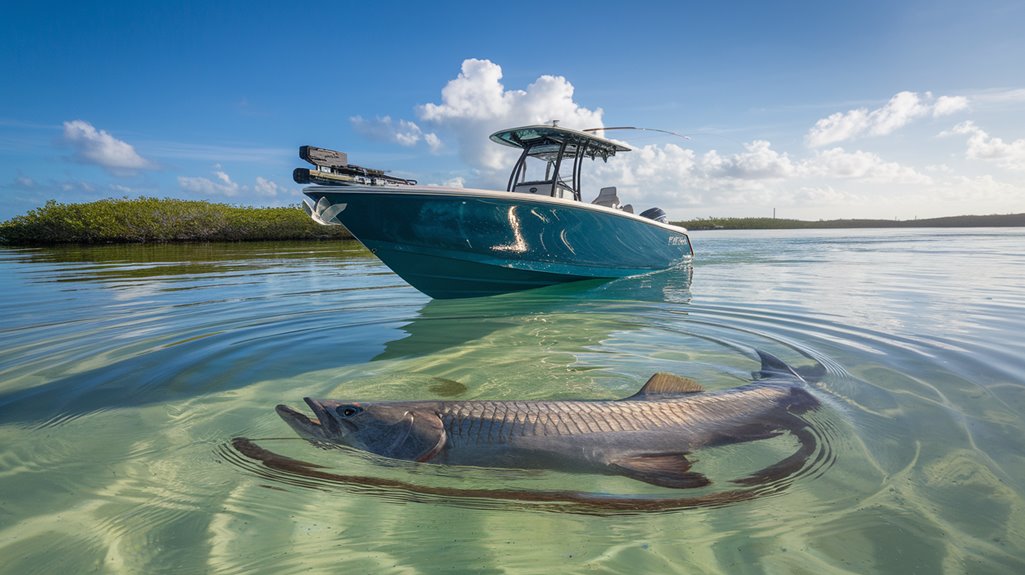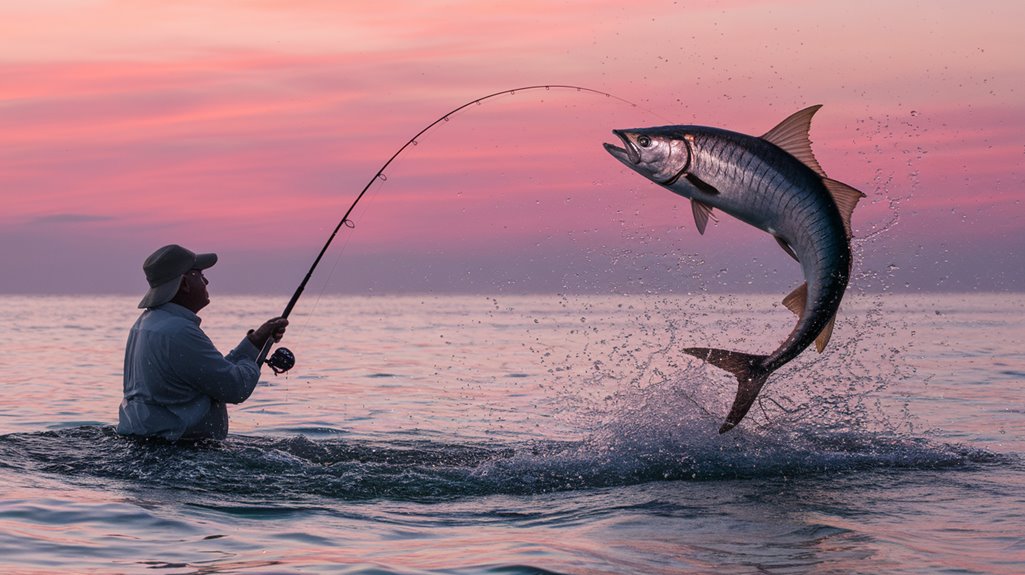You'll find that tarpon fly fishing represents one of angling's most challenging and rewarding pursuits. These prehistoric gamefish, often weighing over 100 pounds, combine raw power with spectacular aerial displays that'll test your skills and equipment to their limits. Whether you're planning your first tarpon expedition or looking to refine your technique, understanding the intricate details of this specialized fishery will dramatically improve your chances of connecting with these magnificent silver kings.
- Key Takeaways
- Understanding Tarpon Biology and Migration Patterns
- Essential Gear and Equipment Selection
- Mastering Critical Casting Techniques
- Optimal Weather and Tide Conditions
- Strategic Boat Positioning and Approach
- Effective Fly Selection and Presentation
- Advanced Fighting and Landing Methods
- Conservation Practices and Handling Guidelines
- Frequently Asked Questions
- Conclusion
Key Takeaways
- Choose appropriate gear: 8-12 weight rods, smooth-drag reels, and 11-12 foot leaders matched to tarpon size for optimal control.
- Master the double haul casting technique to consistently achieve 50-60 foot casts with tight loops in various conditions.
- Position your boat against current at 30-50 feet from feeding tarpon, anchoring where fish will be, not where they are.
- Target tarpon during optimal conditions: water temperatures above 72°F, incoming tides, and light winds near lagoons and creek mouths.
- Practice proper fish handling by keeping tarpon in water, supporting them horizontally, and ensuring full recovery before release.
Understanding Tarpon Biology and Migration Patterns

When you're pursuing the mighty tarpon on the fly, understanding their biological rhythms and migration patterns becomes your foundation for success. These prehistoric predators begin their migratory movements as water temperatures reach 72°F, with peak activity occurring above 78°F. You'll find them traveling both north and south in coastal waters, typically preferring depths of 6-8 feet, though they'll occasionally cross shallow water sand bars.
Your success in tarpon fishing depends on presenting flies in the upper feeding zone where these fish actively feed. Pay attention to water clarity and seasonal spawning patterns, which occur offshore during late spring and summer. While juvenile tarpon can adapt to various coastal environments due to their unique ability to utilize surface air, mature fish become more nomadic, following larger prey sources across their range.
Essential Gear and Equipment Selection
Selecting the right gear for tarpon fishing starts with three essential rod weights matched to your quarry's size. For baby tarpon, you'll need an 8-weight rod with floating 9-weight line. Step up to a 10-weight setup for juveniles, and choose a sturdy 12-weight outfit for adults.
Your fly reel choice is critical – invest in models like the Abel SDS or Ross Evolution R Salt with smooth drag systems that'll handle powerful runs. Keep your rod tip low during the fight. For leaders, build 11-12 foot systems for smaller fish, while adult tarpon demand either shock tippet or straight 80-pound fluorocarbon.
Stock your Tarpon Flies box with proven patterns like the Tarpon Toad and Black Death in sizes 1/0 to 4/0. Practice your double haul until you can consistently deliver flies at 50-60 feet.
Mastering Critical Casting Techniques

Mastering vital casting techniques requires dedicated practice with your heavier tarpon rods to develop the muscle memory and precision needed for success. You'll need to dedicate at least 15 minutes daily to perfecting your Double Haul technique with 10-12 weight rods, focusing on generating tight loops for ideal fly presentation.
Your target should be consistently accurate casts within 50-60 feet, as this range is essential for engaging feeding tarpon. Don't shy away from practicing in windy conditions – these challenging scenarios will strengthen your casting abilities and prepare you for real-world situations. Remember, the tighter your loops, the better your accuracy and the more effectively you'll present your fly in the tarpon's upper feeding zone, appreciably improving your chances of a successful hook-up.
Optimal Weather and Tide Conditions
You'll find tarpon most active and readily feeding once water temperatures climb above 72°F, particularly during their spring migration patterns that align with April's moon phases. Your success rates will improve considerably when you time your fishing with incoming tides, which naturally push fish closer to shore and into prime feeding zones. Watch for light winds and even slight rainfall, as these conditions create ideal environments for targeting tarpon in lagoons and creek mouths where they congregate to feed.
Seasonal Migration Patterns Impact
Understanding tarpon migration patterns is essential for maximizing your success on the water, as these magnificent fish follow predictable temperature-driven movements along the coast. When water temperatures reach 72°F, you'll notice increased tarpon migration activity, with peak movement occurring above 78°F. These seasonal movements create multiple opportunities for skilled anglers who understand how to capitalize on ideal fishing conditions.
To effectively target migrating tarpon, focus on these key factors:
- Position your boat strategically in the fish's travel path
- Monitor moon phases, particularly during April's prime tides
- Track wind direction and its influence on tidal movements
- Observe both northbound and southbound migration patterns
Best Tidal Movement Timing
Successful tarpon fishing hinges on timing your excursions with perfect tidal movements and weather conditions. You'll find the best tidal movement timing during the last two hours of an incoming tide and the first two hours of an outgoing tide, when tarpon are most actively feeding. To maximize your fishing opportunities, plan your trips around overcast days with water temperatures between 72°F to 78°F.
| Condition | Ideal Timing | Impact |
|---|---|---|
| Tide | Last 2hrs incoming/First 2hrs outgoing | Peak feeding activity |
| Moon Phase | New/Full moon periods | Increased tidal flow |
| Weather | Overcast skies | Better visibility |
| Wind | Light breeze | Surface disturbance |
Tarpon anglers who carefully monitor these conditions greatly improve their chances of success. Water temperature triggers migration patterns, while moon phases influence tidal movement, creating prime conditions for targeting these magnificent gamefish.
Strategic Boat Positioning and Approach

When pursuing the mighty tarpon on the fly, proper boat positioning can make the difference between a memorable hookup and a fruitless day on the water. Your strategic boat positioning should account for both current and environmental conditions while maintaining a 30-50 foot distance from feeding tarpon to enable stealthy presentations.
For ideal positioning success:
- Anchor in the fish's anticipated path, not where they currently are
- Position your boat against the current for better casting angles
- Use your trolling motor sparingly to avoid spooking fish
- Adjust your location based on changing tides and wind patterns
Effective Fly Selection and Presentation
When selecting your tarpon flies, you'll want to focus on proven patterns like the Black Death and Tarpon Toad in sizes 1/0 to 4/0, featuring dark colors such as black and purple. You'll need to match your presentation to the tarpon's preferred feeding zone, typically in the upper water column at depths of 6-8 feet. For ideal results, make certain your leader setup spans 10-14 feet with an appropriate shock tippet, allowing your fly to move naturally while withstanding the powerful strikes of these magnificent fish.
Essential Fly Patterns
Three proven fly patterns stand at the forefront of tarpon fishing success: the Tarpon Toad (1/0-3/0), the Black Death (3/0-4/0), and Puglisi's Black and Purple Peanut Butter (3/0).
When you fish for tarpon, you'll need to take into account water depth and clarity when selecting your essential fly patterns. For shallow flats targeting juvenile tarpon, opt for slow-sinking or top-water patterns paired with longer 11-12 foot leaders.
Your fly box should include:
- Black and purple combinations for low-light conditions
- Brown and tan patterns for clear water situations
- Florida yellow varieties for murky water
- Lightweight patterns for skinny-water fishing
Match these patterns with appropriate Fly Line weight and presentation techniques to maximize your chances of enticing these magnificent gamefish to strike.
Reading Tarpon's Feeding Zones
Success in tarpon fishing hinges on your ability to identify and effectively present flies in their preferred feeding zones. The Silver King typically feeds in the upper water column, usually at depths of 6-8 feet, where you'll want to focus your line presentation. You'll find that matching your fly selection to water conditions is critical – black and purple patterns work well in darker water, while brown/tan and Florida yellow excel in clearer conditions.
To hook your first tarpon, position lightweight flies in shallow flats where these predators actively feed. Keep your casts within 50-60 feet and watch for following fish. By carefully observing their behavior and leading them properly during retrieves, you'll maximize your chances of success in these prime feeding zones.
Advanced Fighting and Landing Methods
Landing a trophy tarpon requires mastering several advanced techniques that work together during the fight. When you first hook this powerful fish, keep your rod tip low and maintain steady drag pressure. You'll need to master "bowing to the king" – an essential technique where you drop your rod tip during jumps to prevent the hook from pulling free.
During the battle, you'll need to:
- Strip line after each jump to maintain hook engagement
- Adjust your disc drag gradually as the fish tires
- Stay ready for quick direction changes by positioning yourself strategically
- Keep consistent pressure without sudden jerks that could break your leader
Conservation Practices and Handling Guidelines
While pursuing these magnificent gamefish, responsible anglers must prioritize tarpon conservation and proper handling techniques to secure the species' long-term survival. Conservation efforts led by organizations like Bonefish and Tarpon Trust focus on protecting critical habitats and understanding spawning patterns.
When practicing catch and release fishing, you'll want to match your tackle to the fish's size, reducing fight times and stress. Keep the tarpon in the water whenever possible, and if you must lift it, support it horizontally to prevent internal injuries. Minimize handling and air exposure to increase survival rates. After the fight, assist with oxygen uptake by moving the fish forward in the water until it's strong enough to swim away. These handling guidelines guarantee both the immediate survival and long-term sustainability of the species.
Frequently Asked Questions
What Is the Best Setup for Tarpon Fishing?
You'll need a 10-12 weight rod, large arbor reel with smooth drag, floating line, 10-14 foot leader with shock tippet, and proven flies like Tarpon Toad in 1/0-4/0 sizes.
Why Is It Illegal to Catch Tarpon in Florida?
It's not illegal to catch tarpon, but you can't harvest them. Florida protects these slow-growing gamefish through catch-and-release regulations to maintain their population for future generations of anglers.
What Weight Fly Rod Do You Use for Tarpon?
You'll need an 8-weight rod for baby tarpon (5-15 lbs), 10-weight for juveniles (15-60 lbs), and 12-weight for adult tarpon (60-140 lbs). Match your line weight accordingly.
What Month Is Best for Tarpon Fishing?
You'll find peak tarpon action from May through July, when water temps hit 72-78°F. Focus on the Florida Keys during new and full moons for ideal fishing conditions.
Conclusion
You've now got the fundamentals to pursue one of angling's greatest challenges. Remember to study their behavior, select appropriate gear, and master those essential casting techniques. Don't forget that success with tarpon requires patience, precise positioning, and proper fly presentation. Most importantly, practice conservation-minded handling to guarantee these magnificent fish continue thriving. Now it's time to apply your knowledge on the water.

